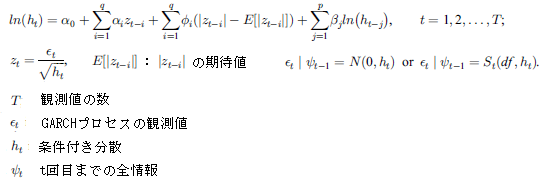Keyword: EGARCH, 実現値
概要
本サンプルはEGARCHプロセスの時系列の実現値の生成を行うC言語によるサンプルプログラムです。 本サンプルは以下の式で示されるEGARCHモデルにより10個の観測値から成る2つの実現値を生成し出力します。

※本サンプルはnAG Cライブラリに含まれる関数 nag_rand_egarch() のExampleコードです。本サンプル及び関数の詳細情報は nag_rand_egarch のマニュアルページをご参照ください。
ご相談やお問い合わせはこちらまで
出力結果
(本関数の詳細はnag_rand_egarch のマニュアルページを参照)| この出力例をダウンロード |
nag_rand_egarch (g05pgc) Example Program Results
Realization Number 1
I HT(I) ET(I)
--------------------------------------
1 2.5098 0.5526
2 2.1785 -1.8383
3 3.3844 1.2180
4 2.6780 1.3672
5 2.0953 -1.8178
6 3.2813 -0.0343
7 2.9958 -0.5094
8 3.0815 1.3978
9 2.3961 -0.0070
10 2.2445 0.6661
Realization Number 2
I HT(I) ET(I)
--------------------------------------
1 1.9327 -2.2795
2 3.5577 -1.2249
3 4.1461 0.6424
4 3.4455 -2.9920
5 5.9199 0.5777
6 4.8221 -1.2894
7 5.3174 -1.6473
8 6.1095 6.1689
9 3.1579 2.2935
10 2.2189 0.1141
- 7〜16行目に1つめの実現値の条件付き分散と観測値が出力されています。
- 21〜30行目に2つめの実現値の条件付き分散と観測値が出力されています。
ソースコード
(本関数の詳細はnag_rand_egarch のマニュアルページを参照)
※本サンプルソースコードはnAG数値計算ライブラリ(Windows, Linux, MAC等に対応)の関数を呼び出します。
サンプルのコンパイル及び実行方法
| このソースコードをダウンロード |
/* nag_rand_egarch (g05pgc) Example Program.
*
* CLL6I261D/CLL6I261DL Version.
*
* Copyright 2017 Numerical Algorithms Group.
*
* Mark 26.1, 2017.
*/
/* Pre-processor includes */
#include <stdio.h>
#include <math.h>
#include <nag.h>
#include <nag_stdlib.h>
#include <nagg05.h>
int main(void)
{
/* Integer scalar and array declarations */
Integer exit_status = 0;
Integer lr, i, lstate;
Integer *state = 0;
/* nAG structures */
NagError fail;
Nag_Boolean fcall;
/* Double scalar and array declarations */
double *et = 0, *ht = 0, *r = 0;
/* Number of terms to generate */
Integer num = 10;
/* Normally distributed errors */
Nag_ErrorDistn dist = Nag_NormalDistn;
Integer df = 0;
/* Set up the parameters for the series being generated */
Integer ip = 1;
Integer iq = 1;
double theta[] = { 0.1e0, -0.3e0, 0.1e0, 0.9e0 };
/* Choose the base generator */
Nag_BaseRNG genid = Nag_Basic;
Integer subid = 0;
/* Set the seed */
Integer seed[] = { 1762543 };
Integer lseed = 1;
/* Initialize the error structure */
INIT_FAIL(fail);
printf("nag_rand_egarch (g05pgc) Example Program Results\n\n\n");
/* Get the length of the state array */
lstate = -1;
nag_rand_init_repeatable(genid, subid, seed, lseed, state, &lstate, &fail);
if (fail.code != NE_NOERROR) {
printf("Error from nag_rand_init_repeatable (g05kfc).\n%s\n",
fail.message);
exit_status = 1;
goto END;
}
/* Calculate the size of the reference vector */
lr = 2 * (2 * iq + ip + 2);
/* Allocate arrays */
if (!(et = nAG_ALLOC(num, double)) ||
!(ht = nAG_ALLOC(num, double)) ||
!(r = nAG_ALLOC(lr, double)) || !(state = nAG_ALLOC(lstate, Integer)))
{
printf("Allocation failure\n");
exit_status = -1;
goto END;
}
/* Initialize the generator to a repeatable sequence */
nag_rand_init_repeatable(genid, subid, seed, lseed, state, &lstate, &fail);
if (fail.code != NE_NOERROR) {
printf("Error from nag_rand_init_repeatable (g05kfc).\n%s\n",
fail.message);
exit_status = 1;
goto END;
}
/* Generate the first realization */
fcall = Nag_TRUE;
nag_rand_egarch(dist, num, ip, iq, theta, df, ht, et, fcall, r, lr,
state, &fail);
if (fail.code != NE_NOERROR) {
printf("Error from nag_rand_egarch (g05pgc).\n%s\n", fail.message);
exit_status = 1;
goto END;
}
/* Display the results */
printf(" Realization Number 1\n");
printf(" I HT(I) ET(I)\n");
printf(" --------------------------------------\n");
for (i = 0; i < num; i++)
printf(" %5ld %16.4f %16.4f\n", i + 1, ht[i], et[i]);
printf("\n");
/* Generate a second realization */
fcall = Nag_FALSE;
nag_rand_egarch(dist, num, ip, iq, theta, df, ht, et, fcall, r, lr,
state, &fail);
if (fail.code != NE_NOERROR) {
printf("Error from nag_rand_egarch (g05pgc).\n%s\n", fail.message);
exit_status = 1;
goto END;
}
/* Display the results */
printf(" Realization Number 2\n");
printf(" I HT(I) ET(I)\n");
printf(" --------------------------------------\n");
for (i = 0; i < num; i++)
printf(" %5ld %16.4f %16.4f\n", i + 1, ht[i], et[i]);
END:
nAG_FREE(et);
nAG_FREE(ht);
nAG_FREE(r);
nAG_FREE(state);
return exit_status;
}
